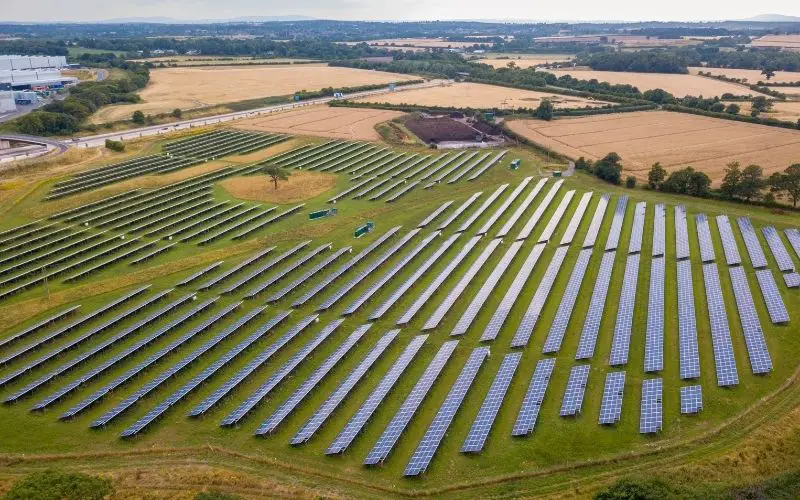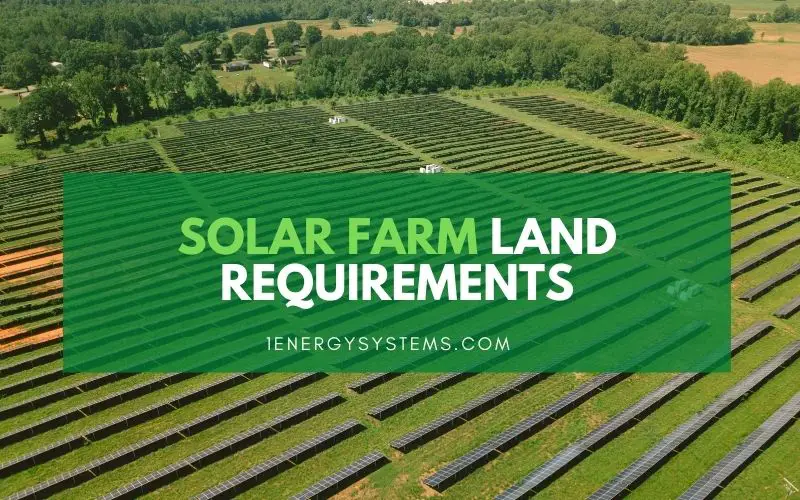If you are a farmer, rancher, or landowner experiencing the devastating effects of climate change, your sense of despair is understandable.
With extreme temperatures, droughts, floods, and hurricanes ravaging your land, your very survival is at stake.
If you are thinking of selling your property, wait! There is some good news for you.
You can consider leasing out your land to a solar energy farm. By choosing this, you can generate a regular income for 25 or 50 years. If this seems appealing, read on.
This article will give you all the information that you will need to figure out whether your land meets the solar farm land requirements. You will also find the pros and cons of leasing the land to a solar farm and tips to ensure you are doing it right.
Should you lease your land for solar farming?
In case you have large tracts of unused land and are looking for ways to generate income from it, leasing the land to a solar energy farm may be a good idea. Here are some of the pros and cons of the arrangement.
Pros
- You can ensure a steady income for the lease period.
- You are guaranteed financial security.
- You can support the local economy with the creation of green jobs.
- You can help local government services through extra property taxes accrued for the solar farm.
- You can help in bringing down the consumption of fossil fuels.
- You can help the country gain energy independence.
Cons
- You may have to pay higher property taxes as the land classification will change from its current status.
- If the land-use changes from agricultural use to commercial, you may have to pay tax penalties.
- The lease amount could be lower than the agricultural income from the land. (Lease the land only if it is no longer cultivable)
- In case the solar farm fails to take off before your land lease expires, you may end up with a land full of solar panels. It would be hard to get the land ready for farming.
- At the time of the feasibility study for the solar farm, you may have to bear extensive damage to crops and other installations on the land.
Leasing your land to a solar energy farm is a profitable move only if your land is uncultivable and lying unused.

How to know that your land is suitable for a solar energy farm lease?
Each piece of land comes with its own unique potentials and drawbacks. The best procedure to determine the feasibility of the land to set up a solar energy farm would be to approach the solar developer. However, you can use these as general guidelines to give you a rough idea.
1. Size of the land
As a rule of thumb, 1 MW of solar power generation will require 4-5 acres of land; the solar panels require 2.5 acres (1kW of solar panels require 100 sq. ft) and the rest for solar equipment. Some suggest up to 8 acres for each MW.
Even if you consider 5 acres for 1 MW, you may not be able to use your entire land for setting up solar panels. Local zoning regulations may allow only a part of the land for use after setbacks and other restrictions. This is usually in the range of 60% of the land. This means if you have a 10-acre land, only 6 acres may be used to set up the solar farm.
This means a 10-acre plot can generate solar power of roughly 1 MW.
A community-level small solar farm typically is 1-10 MW in size and commercial solar farms are 25MW-1GW in size.
2. Condition of the land
Your land may be unusable for growing crops. That is not an issue for a solar energy farm. But to set up a solar farm, your land needs to satisfy certain conditions.
- Flat, clear land
- No wetland
- Land incline less than 5 degrees
- Availability of sunlight year-round
- Stable land to accommodate the solar equipment
- Absence of vegetation
Though smaller vegetation like shrubs and bushes can be removed, it will raise the overall cost of the project. If there are bigger trees, they may create shades that are not good for solar power generation.
3. Proximity of infrastructure
The location of your land will play a major role in its potential for a solar farm. The solar energy generated in the farm is fed to the grid. This is usually done in a substation. The distance of the substation from your property can impact the viability of the arrangement.
If your property is too far away from the substation, the solar farm developer needs to spend a higher cost to connect the farm with the substation. The general rule of thumb is within two miles.
Besides the substation, the availability of a three-phase power line is also important. Each extra mile of electrical feeder will add approximately $500,000 to the project cost.
Access to infrastructure like wide roads can make your land more attractive for the developer. Proximity to towns and cities will offer better access to infrastructure essential for building, operating, and maintaining the solar farm for the developer.
4. Local rules and regulations
If local regulations restrict the setting up of solar farms on agricultural land, nothing can be done about it. The local laws should be clear and in favor of the construction, interconnection, and operation of the solar panel farm. Or else, the developer and landowner are bound to have a tough time.
If the land regulations are highly restrictive about the ratio of land that can be used for the construction, the developer may lose interest in the project. In case the use of land for a solar energy farm project necessitates too many permits and licenses, the project has less chance of taking off. This is typically the case in place with fewer solar farms.
While some local governments insist on visual buffers or solar farm screening, others stipulate that certain areas remain undeveloped for ecological reasons. Such as the habitat of a protected species of animal, bird, or plant.
5. Chance of flooding
This is a major concern for solar farm developers. Risk assessment for flooding is one of the first tasks included in the feasibility study for the solar farm project. With all the solar panels located barely a few feet above the ground level, flooding can damage the panels extensively and put the entire solar farm out of commission.
This doesn’t necessarily mean that solar farms cannot be built on floodplains. If suitable land is not easily available in the area for the solar farm, the developer may still choose to build the farm on a floodplain. It will require extra care to ensure that the solar equipment can withstand potential flooding and the panels are mounted higher. This is bound to raise the budget for the project.
Tips to ensure a steady income by leasing your land for a solar farm
If your land meets solar farm land requirements, most probably multiple developers are interested in leasing your land. As there is much demand for producing solar energy and there are few large land parcels available for building solar panel fields, be ready to be pursued relentlessly by solar developers. You may not have to do any paperwork and they may entice and prompt you to sign the lease agreement.
There are numerous financial advantages for you. However, you also need to stay alert and guard yourself against the risks involved. If you do not do your homework, you could lose your advantage and benefits and would regret it later.
Here are some tips to ensure that you are not taken for a ride by the solar developers.
- Hire a lawyer who is well-versed in this kind of deal. It must be someone whom you can trust to protect your exclusive interests.
- Read and understand the documents before you sign them.
- Include in the lease agreement:
- Payment of additional property taxes by the developer
- Compensation for crop damage
- Proper maintenance of the land
- Create an escrow account to cover the cost of the removal of cement ballasts and solar panels when the lease expires
- Conduct background checks to ensure the developer is genuine.
- Collect multiple offers before settling on the best one. Get help from your lawyer to figure this out.
- Don’t believe everything the developers are telling you. Do your own investigation to find out the truth.
- You may contact experts in the solar energy industry to get a second opinion before making the decision.
Bottom line
If you have a large tract of uncultivable land, leasing it out for a solar farm is indeed a good idea. However, you must do sufficient homework before committing to a deal. The first step would be to determine whether your land meets the solar farm land requirements.
Solar farm developers are eagerly seeking land to build their projects. If you’re interested in leasing your property for solar development, tread with caution.
On the other hand, you can also set up a solar energy farm to provide power to your agricultural needs. A 1-acre solar farm cost would be approximately $500,000.
Recommended Reading:

